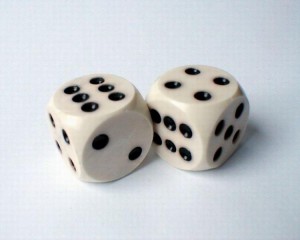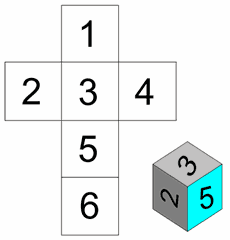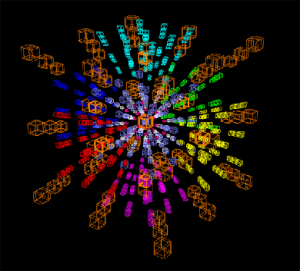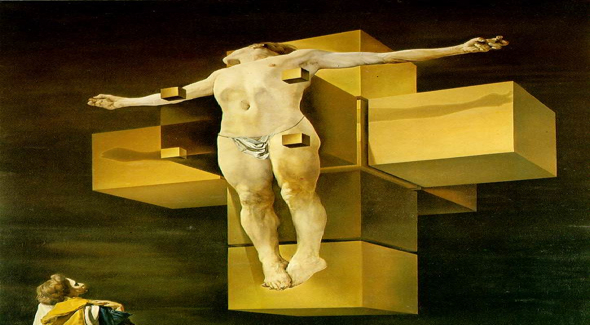My post last week on Starship Troopers’ fascism generated a lot of good debate in the comments. This site thrives on intelligent comments – as well as generous donations, hint hint – so we knew we’d hit on a rich lode of pop culture. And like every mining company, we exploited that lode for all it had.
The debate around Starship Troopers hinged on a few key questions:
- Was Starship Troopers a good movie or a bad movie?
- Re: question #1, was that Verhoeven’s intention or no?
- Re: question #2, was that because Verhoeven was satirizing fascism or wallowing in it?
- Re: question #3, was that because Verhoeven was true to the source (Heinlein’s novel) or deviated from it?
As you can see, this isn’t just a checklist of criticism. Each answer hinges on the one prior to it. The possibilities unfold like a space-time origami crane. How could each of the distinct viewpoints interact with each other and come to a consensus?
Fortunately, loyal commenter donn hit on a solution:
It seems like it’s almost time for a chart here…
Ladies and Gentlemen, loyal Overthinkers, I present to you the Four-Dimensional Matrix of Starship Troopers Criticism!
Here’s how to use the Four-Dimensional Matrix of Starship Troopers Criticism. Simply complete the following sentence:
Starship Troopers was [1], and that was [2] on Verhoeven’s part, because his [3] is [4]
[1] = “Awesome” or “Terrible”
[2] = “Intentional” or “Accidental”
[3] = “Satire of Fascism” or “Wallowing in Fascism”
[4] = “True to the Source” or “Deviates from the Source.”
For instance, it is Overthinking It’s position that Starship Troopers was Awesome, and that was Intentional on Verhoeven’s part, because his Satire of Fascism is True to the Source. He took the militarism in Heinlein’s novel just a nudge farther in order to turn it into painfully hilarious insight.
Roger Ebert would agree with me that Verhoeven intended a Satire of Fascism and that it was True to the Source. He cites Heinlein’s novel in his review. However, Ebert believes that Starship Troopers is Terrible, and that that was an Accident on Verhoeven’s part.
So Ebert’s views and mine are co-planar on the third and fourth dimension, but divergent on the first and second.
Verhoeven himself, meanwhile, would probably say that he made a deliberately Terrible movie. So Verhoeven and Overthinking It converge on the second, third and fourth planes but share no common points on the first.
Each of these 16 distinct viewpoints can be mapped to a vertex on a hypercube – a four-dimensional cube. Humans cannot naturally perceive four dimensional objects. Our ancestral needs and evolutionary pressures limited us to three: length, width and depth. We can see three-dimensional cubes with ease, whereas a two-dimensional creature – a Flatlander – could not.

This is not going to blow anyone\’s mind.
But a two-dimensional creature could see a three-dimensional cube if we unfolded it and laid it flat. We recognize these images from standardized tests, like the SATs in America or le bac in France.

Almost blowing your mind … almost …
So what if we unfold a four-dimensional cube so that we three-dimensioners could perceive it? Why, it might look a little something like this:

HOLY $#!& I HAVE JUST BLOWN YOUR MIND.
The four-dimensional cube, also called a hypercube or tesseract, has 16 different vertices (or “corners”). If we could smoosh this cube flat, the 16 vertices would unfold into a beautiful floral arrangement. Coincidentally, the Four-Dimensional Matrix of Starship Troopers Criticism hosts 16 possible viewpoints. Each of those viewpoints can be mapped to a vertex on the tesseract.

So whether or not Starship Troopers is good, bad, deliberate, accidental, satirical, exploitative, true to its source or false, it is at least proof that humanity’s ability to conceive higher dimensions has a use. Flatlanders couldn’t even begin to appreciate this movie.
But wait! There’s more!
Could other Verhoeven films be critiqued using the Four-Dimensional Matrix of Starship Troopers Criticism? Of course! Replace the “Fascism” with “Sexism” in [3]. Change the options in [4] to read “Empowering Women” or “Demeaning Women.” And there you have it – a Four-Dimensional Matrix of Showgirls Criticism!
In fact, Stokes’ whole analysis of Showgirls and Good/Bad Movies fails! It fails, sir, because you’re not thinking fourth-dimensionally! The points on this chart exist not independently of each other, but in an interrelated four-dimensional nexus of quality, intentionality, sincerity and integrity! The possibilities explode beyond the conventional limits of our Euclidean world! You LOSE! Good DAY, sir!
Of course, it takes no more than four dimensions to evaluate a Paul Verhoeven film. Or any film at all, really. Let’s be reasonable. If you added a fifth dimension to the matrix, then you’d have … you’d have something like …

AAAAAAAAAAAAAHHHHH! *head explodes*


Must we quibble on all things Starship Troopers? Since the conditions are successive this would be more appropriately represented by a binary tree, and many of us don’t care to go past [1] = “Terrible” to condition [2].
When you look at that four-dimensional cube, remember that Hyper-Jesus died for your transdimensional sins.
“The points on this chart exist not independently of each other, but in an interrelated four-dimensional nexus of quality, intentionality, sincerity and integrity! The possibilities explode beyond the conventional limits of our Euclidean world! You LOSE! Good DAY, sir!”
This would be biting snark, if hypercubes weren’t objects defined in four-dimensional EUCLIDEAN space.
@Valatan: math isn’t my forte, but I thought the tesseract itself was non-Euclidean (since it’s 4-D), whereas the hypercube (the cross-like thing) was a Euclidean representation of same. So the critique of Starship Troopers itself lies beyond human perception, but we can conceive it – and model it imperfectly – using this squashed-flat 3D model.
I will yield to better geometers, however.
@Donn: I contend that Terrible-Intentional is sufficiently different from Terrible-Accidental, and that Terrible-Intentional-Satirical is sufficiently different from Terrible-Intentional-Wallowing, and so forth, that they’re worth distinguishing.
And yes, any 4-dimensional construct can be modeled in 2 dimensions (witness the 16-point “floral” diagram that models the vertices of a tesseract). But think of the possibilities!
@perich
(FWIW, I’m a relativity researcher, but I do have astounding abilities to be wrong), typically, the Euclidean/Non-Euclidean distinction is one used to refer to the curvature of space: a plane is a two-dimensional Euclidean space, while a Sphere is not.
Similarly, the hypercube is an object that lives inside of a flat four dimensional space. Since this space lacks curvature, then most mathematicians would refer to it as an Euclidean space, irrespective of its dimension.
@Valatan: good to know!
My use of the term “Euclidean” probably comes from what little I remember of H.P. Lovecraft. I would not be shocked if he were wrong about geometry.
Euclidian verses non-Eclidean geometry is all about parallel lines.
Definition: Two strait lines are defined as parallel if any third line which intersects both has interior angles on the same side which add up to two right angles.
Euclid’s Elements starts with 5 axioms (assumed to be true but unprovable rules) one of which is that any two non-parallel strait lines intersect if extended infinitely (being able to extend any strait line infinitely is an earlier axiom). This is the “Parallel Postulate”. There are many logically equivalent axioms to put in it’s place, but that’s the one Euclid used.
If you throw out this axiom and put something else in you are working in non-Euclidean geometry. You could throw out any of the axioms and be working in non-Euclidean space, but that’s the one that people have studied alternatives to. I imagine Lovecraft might have been throwing out more axioms we he refered to non-Euclidean geometry since he didn’t have to come up with a logically consistent set to but in their place.
Have you ever toyed with the idea that you think it’s awesome because it’s so terrible? Or do you genuinely think it’s Awesome (with the capitalization and all)?
I point out again, since nobody seems to have reacted to it in the last thread, that he cannot be true to the source, because he did not actually -read- the source. He got a few chapters in, and became “bored and depressed” and stopped reading.
@Sean Nixon:
If you wanted to take a COMPLETELY modern way of looking at it, you might argue that the most important departure from Euclid is that you should reject one of his unstated postulates: that space is completely homgoneous–that every point “looks” like every other point. There are worlds of rich structures that you can find in geometry if you relax this assumption.
It is true that the non-absoluteness of euclidean geometry was established in the early 19th century when it was proven that Non-Euclidean homogenous geometries existed. But it was a true explosion when Gauss and Riemann discovered that you could develop all sorts of non-homogenous geometries, and it was even more fundamentally shaken when set theory and topology got developed, and it was found that you could find out a lot of geometric truths without even making reference to distances at all.
Dan – but why should that matter? The movie either is or is not similar to the book. Whether Verhoeven realized it or not is a separate issue.
I didn’t make a chart out of this but here’s Verhoeven’s budget, domestic theatrical gross, budget to domestic gross, and budget to domestic differential for his Hollywood movies (numbers are adjusted for inflation):
Robocop, 24m, 100m, 4.11, +76m
Total Recall, 106m, 195m, 1.84, +89m
Basic Instinct, 74m, 179m, 2.4, +105m
Showgirls, 63m, 28m, 0.45, -35m
Starship Troopers, 141m, 73m, 0.52, -68m
Hollow Man, 118m, 91m, 0.77, -27m
Robocop was a bonanza – small budget, big return. Total Recall in absolute numbers was also very profitable, and Basic Instinct, in absolute numbers, even moreso. Then the wheels fell off. The first three movies and the last three movies are like mirror images of each other.
Robocop – man loses humanity, recovers humanity.
Total Recall – man fights fascist/corporate state.
Basic Instinct – didn’t watch it.
Showgirls – didn’t watch it – had boobies.
Starship Troopers – fascists fight bugs.
Hollow Man – man loses humanity, does not recover humanity.
If he was intentionally making bad movies he did a good job of it and lost a lot of people a lot of money.
@Stokes Then Parich is -still- inaccurate in his pick for how to characterize the movie. As he has it both true to the source material, and -intentionall- true to the source material.
Either it isn’t true to the source material because you need to actually -know- what it is before you can be true to it, or whether it is true to the source material or not, it cannot be intentionally so, since again, he didn’t read the source material.
Further, correct outcomes based on faulty inputs are still bad science.
@Dan from Canada –
If you’re arguing that Starship Troopers is bad science, I TOTALLY agree. I mean, submit that shit to a peer-reviewed journal, see how far it gets you. I mean, Verhoeven’s research is painfully derivative of Riefenstahl et al (1934), which he doesn’t even cite, plus, as Starship Troopers 2 and 3 have proved, his results are not reproducible. ;-p (I kid, I kid.)
In all seriousness, though, we have a fundamental disagreement on the issue of whether you can be true to the source without knowing what the source is. I do see where you’re coming from – something about the phrase “true to the source” implies a conscious decision – but I still think you’re getting caught up in a technicality. How about we just substitute that phrase for “is the same as the source.” Is that okay? I mean, I’ve never read The Grapes of Wrath, but if I decide to make a film version and name the main family Joad, it’s still the same as the source.
It’s true that there are some places where the matrix could be logically inconsistant. Take “Verhoeven made a movie that is intentionally awesome, because its satire of facism is the same as the source.” If the film is intentionally awesome, we assume that he knew what he was about, and if he didn’t know what the source was like, presumably he didn’t know that his version was the same. But if you just reverse the causal relationship, it works perfectly: “Because Verhoeven wanted to make an awesome movie and succeeded, his satire of facism ended up being pretty much the same as the source’s satire of facism.”
Seems I’m late to the party…this is more relevant to the other thread, but comments are closed so I’ll throw it in here for the lols. I’ve pondered the relationship between Starship Troopers, its fans and detractors, and critics before and I think a lot of the angst is basically misunderstanding of the subject matter due to dangerously oversimplified cultural precepts.
Everyone agrees that both the novel and movie at least attempt to satirize fascism/militarism, with varying success. The trouble is a lot of people have, through lazy history, concluded that all fascists are Nazis. Mention to anyone born after 1975 or so that one of the WW2 neutrals was a bona fide fascist dictatorship which existed well into the ’70s (Spain) and you’re likely to get puzzled looks. Nor do people talk much about how even the other Axis powers privately thought Hitler was a total flaming psychopath who would get them all killed. This is intensely relevant because both book and movie show the military-political regime as extremely dysfunctional but not Always Bad All The Time as we have been conditioned to respond to any mention of the word fascism. Indeed, the book in particular makes the near-heretical assertions that the ideology itself is morally neutral (“bad fascism” stems from crappy leadership e.g. the overly confident general), and sometimes off-the-chain militarism is an inevitable, perhaps even necessary consequence of dire threats to personal and national well-being. Verhoeven–to his credit–doesn’t really shy away from this, as he leaves in plenty of hints that the government may simply be the least of many evils.
And so, I think this incongruity between what we’re “supposed” to think and what we see on screen or page leads many to a sort of automatic revulsion where people feel compelled to hate the movie. Hence why many critical pans turn in on themselves, lauding aspects they subsequently hold up as the reason for its failure. There’s still plenty of room for criticism of form and substance, but I’m convinced a major reason a lot of people don’t get Starship Troopers is they don’t understand true fascism.
@CppThis: intelligently put! It’s also worth noting that, prior to the invasion of Poland, the UK and the US were much more tolerant of Hitler’s methods than history might suggest.